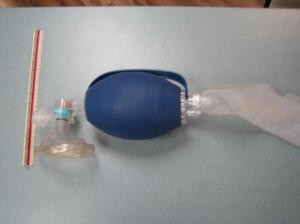It is very important for first aiders and EMTs to know how to provide basic life support in the absence of any special devices. Establishing and keeping the airway open, providing artificial respiration, and applying CPR can be accomplished without using special equipment. Usually, first aiders initiate basic life support this way.
Even though CPR is possible without emergency equipment, using breathing aids can help significantly improve the outcome of the victim. There are different devices that are used to open and keep airway open, clear the airway, provide oxygen and assist in ventilation. These devices are specially designed to ensure maximum blood oxygenation in the lungs, at the same time help reduces fatigue on the part of the first aider. Advanced first aid courses equip participants with knowledge and skills on how to use and maintain different oxygen delivery devices and equipment.
However, never postpone or delay life support measures in order to find, retrieve or set up oxygen delivery devices and other special equipment. Ideally, all first aid equipment should always be ready for immediate use.
Important Facts
Here are some important things to remember when using equipment and devices for basic life support:
- Make sure the equipment is clean and operational before using it on a victim. Basic life support devices should be checked regularly – before and after every shift for EMTs and first aiders.
Individuals enrolled in St Mark James programs with additional CPR HCP (Health care provider) training will learn to use assisted ventilation equipment such as the bag-valve mask pictured above. - Select equipment that is appropriate for the victim’s condition.
- Monitor the victim closely after using any airway device, oxygen-delivery system, or ventilation-assist device.
- Make sure all basic life support equipment is properly tested, cleaned or discarded after every use.
Different Aids
There are many different aids to breathing that are used during emergency and first aid situations.
Airways – These devices are made of plastic material and are inserted, either in the mouth (oropharyngeal airways) or nose (nasopharyngeal airways). Airways should never be used on conscious victims as it can cause vomiting.
Suction Devices – These devices are used to clear the airways with phlegm, blood, vomitus and other secretions. They supplement the manual methods of removing obstructions in the airway.
Ventilation-Assist Devices – As the name suggests, these devices are used to assist with ventilation. Ideally, these devices are used with supplemental oxygen although they can be apart from oxygen supply. Before using ventilation-assist devices, make sure that the airway is open and clear of obstructions. Check for rising and falling of the chest, and improvement in colour of victim. Some of the most commonly used ventilation-assist devices include:
- Pocket Face Mask – These masks offer a safe and efficient oxygen delivery and are available with or without oxygen inlet. Mouth-to-mask ventilation is delivered through the chimney of the mask. This method can deliver as much as 60% oxygen, especially when used with supplemental oxygen.
- Bag-Valve-Mask – This hand-held device deliver positive air pressure to the lungs. It can be used with or without oxygen supply and can deliver as much as 100% oxygen. Take note, however, that maintaining a good seal can be quite difficult, often causing reduce oxygenation delivery.
Breathing aids can significantly improve the outcome of an emergency situation. It is important that every designated first-aider knows when and how to use each device. If you want to learn more about how to use the different breathing aids, you should consider attending an advanced first aid course (register here). Check with your local St Mark James Chapter for training schedules.
